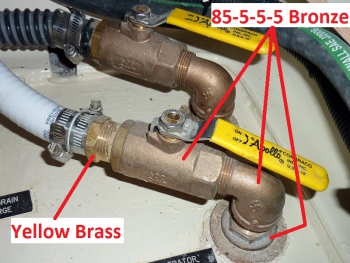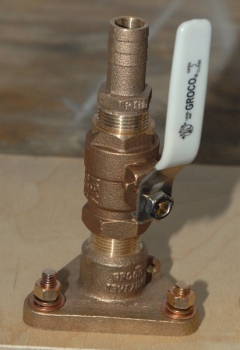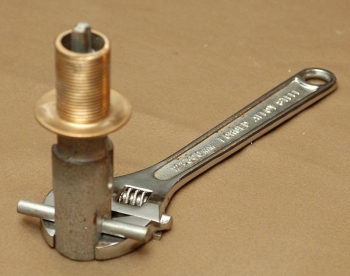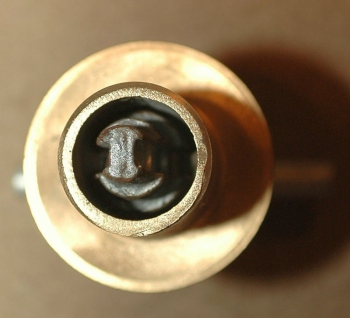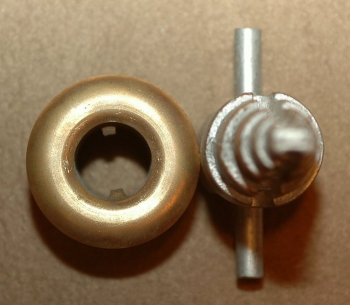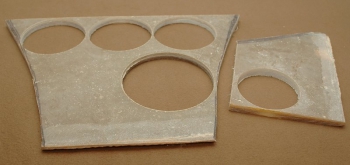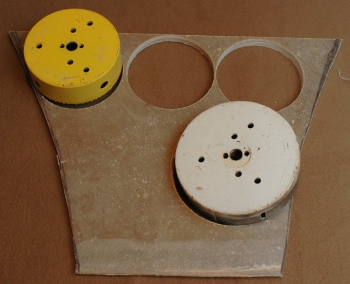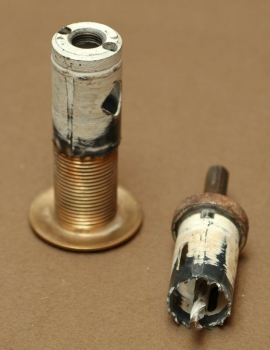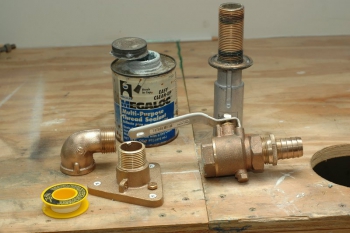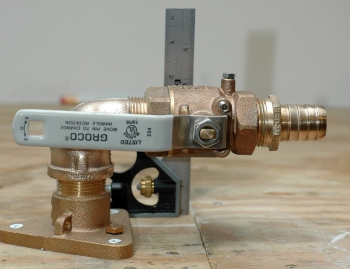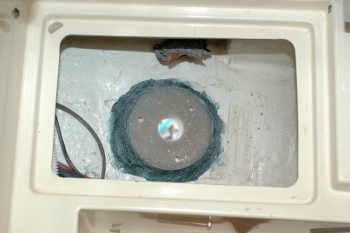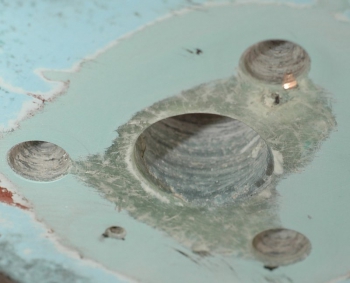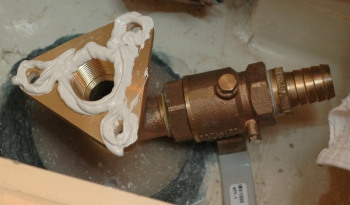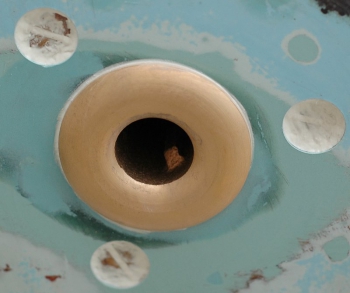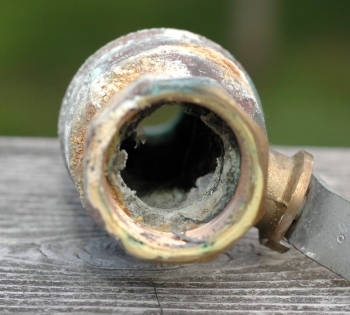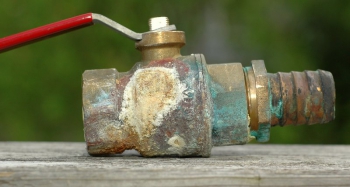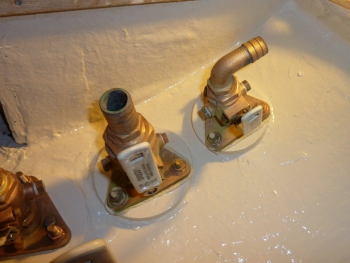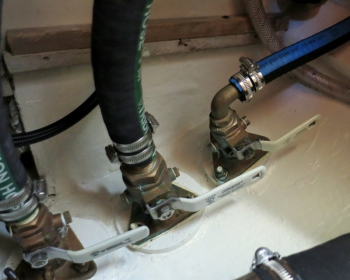A Poor Idea
The picture on the left is what not to do if starting from scratch and installing new seacocks. If your thru-hulls and valves, on your boat, are installed & look similar to this configuration, you’re not alone. This photo was taken on a brand new 2011 production sailboat and this installation does not meet ABYC H-27 standards, despite this builder claiming to build to ABYC standards.
Unfortunately, for many owners of production boats, the factories cut many corners to save money, proper flanged seacocks being one of them. This is understandable as the cost savings over many hundreds of boats is huge to the manufacturer. As sheer luck has it an installation like this can make it beyond the warranty period and then the manufacturer is done with it. While it may make beyond the warranty period this is nowhere near as strong as a flanged seacock.
A proper seacock installation involves more than just a thru-hull/skin fitting/mushroom-head, as some refer to them, and a valve. The problem becomes more complicated when you learn why this is not necessarily the safest way to install a seacock.
The vast majority of all available thru-hull fittings have what’s referred to as a straight thread or NPS (National Pipe Straight Thread), and the vast majority of all ball valves are a tapered thread or NPT (National Pipe Tapered Thread). NPS thread and NPT thread are not intended to be used together. Many unknowing boaters sadly know nothing about NPT or NPS threads and as such often use the two together quite incorrectly.
In short, a proper seacock should have a female NPS flange that is physically bolted to the hull to which the NPS straight thread thru-hull or mushroom head is then threaded into.
Another major problem with this installation is the mismatching of metals below the waterline. That hose barb is yellow brass and not bronze. This particular builder claimed in 2011 to build their vessels to ABYC standards but the ABYC H-27 standard / UL 1121 standards specifically states that all metals shall be galvanically compatible.
UL-1121
“The components of a through-hull fitting or sea valve shall be formed of galvanically compatible materials having the strength and resistance to corrosion necessary to withstand intended and abnormal use to which they are likely to be subjected.”
Here’s the problem, 60/40 yellow brass and 85-5-5-5 marine bronze bronze are not galvanically compatible and never have been. The 60/40 brass will become the anodic metal. ABYC compliant build my a$$!
Please remember this was a 2011 vessel. The picture below, of the broken thru-hull, comes from this same builder.
A Much Better Idea
While both this photo, and the previous photo, were taken on my workbench the plywood is representative of the hull of your boat and the bronze fittings of two very typical installation methods used today. In this photo one can easily see the major differences in how both of these installations are affixed to the hull.
This photo is representative of a proper seacock installation with a through-bolted flange and the previous photo of a not-so-good installation method with no flange and mismatched threads.
Removing the Old Thru-Hulls
- First remove any hose clamps attached to the hose.
- Next remove the hose from the valve.
- Using pipe wrenches remove the valve from the thru-hull.
- Using pipe wrenches or in some locations a chisel remove the locking nut from the thru-hull.
- Apply heat in the form of a heat gun to the exterior of the mushroom head part of the thru-hull.
- While it’s still hot use the step wrench to break the thru-hull free from the hull and remove it.
- If it was put in with a product like 3M’s 5200, & does not want to break free, sliding a three foot pipe over the wrenches handle will give you the leverage needed. You can also use a pipe wrench on the threads to break it free but this will ensure total destruction of the thru-hull.
- If all of the above methods fail to break it free from the hull use a 4 1/2 inch angle grinder and grind it out being very careful not to get it too hot from the grinding so you burn the hull.
A Close Up
Here’s a close up view of the step wrench, and it’s slots, inserted into a thru-hull.
The Dogs
This photo shows the dogs or ears inside the thru-hull that allow the slot on the step wrench to grab hold and break it free or tighten it.
Making Backing Plates
Unless your hull is close to an 3/4″ thick, of solid fiberglass, you’re going to need backing plates for the seacocks. Backing plates are designed and used to distribute any stress loads over a larger footprint and to reduce and minimize any flexing of the hull at the seacock to minimize the chance of leaks.
While most boat yards and DIY boaters use wood, because it’s quick and easy, there really is a more permanent method and that is fiberglass, the same material your hull is made of.
Of course if you have a beautiful old wooden boat don’t use fiberglass. Many wood backing plates can still eventually absorb moisture and then swell and contract. Over time this can lead to a possible compromise the fit of the seacocks and the water tight integrity. Most wood’s are also far softer than solid fiberglass so it can flex some with the constant opening and closing of a seacock.
Many folks swear by coating the wood with epoxy, which I’ve done over the years, but in my experience, it really does not take that much more effort to make them out of fiberglass.
I use ssolid fiberglass for backing plates exclusively so these instructions show how to do that. If you want to use wood just replace the “epoxy” or “kitty hair” step with a product like Sikaflex 291 or 3M 4200 and secure the wood to the hull with that.
Fiberglass backing plates are easy to make but yes they are admittedly a little more time consuming. The benefit is that once you have glassed these into the boat they will last a lifetime and never need replacing. Even if you replace the seacocks ten+ years down the road the backing plate can be re-used.
My motto;
“Any job worth doing, is a job worth doing right.”
Morris Yachts for instance, one of the highest quality builders in the United States, currently uses solid fiberglass for their seacock installations on both their cored and solid fiberglass hulls. I personally feel wooden backing plates are a compromise but please do remember what you paid for this opinion when making your own decisions.
TIP: To save yourself time G-10 (epoxy resin & fiberglass) or GPO-3 (polyester resin & fiberglass) pre-formed sheets can be used in place of home made fiberglass sheets.
Fiberglass Backing Plates:
To make solid fiberglass backing plates you will need the following items.
- Fiberglass laminating resin & hardener + some finishing or waxed resin.
- Fiberglass in both 18oz Woven Roving and a standard 6oz Fiberglass Cloth.
- A 24 X 24 inch piece of relatively thick glass.
- A Fiberglass roller.
- Mold release wax for the glass.
To make the backing plate board wax the glass and begin laying up, wetting out, rolling & alternating the layers of roving and cloth until you have a fiberglass board approx 5/8″ thick. The whole laminating process may take you 30 minutes. The finishing resin goes on as the last coat so it does not dry tacky.
You may also be able to find scrap pieces fiberglass around your boat yard. This would save some time instead of laminating the backing plates yourself. Even two thicknesses of thinner fiberglass epoxied together is less work than actually doing the laminating. So ask around at the yard you never know what you might find.
What about Starboard?
OK I’ve had numerous questions about the use of the plastic marine lumber Starboard and it’s many knock off iterations such as SeaBoard. Starboard is not a suitable product for a backing plate.
- Starboard is far to flexible to offer any sort of rigid stiffening to the hull.
- It does not stick well to any adhesives, which includes bedding compounds such as 5200, 4200 or Sikaflex and the manufacturer even backs this up. Starboard backing blocks can lead to leaks below the waterline!
- The concept of a backing plate is to become one with the hull, make it thicker and add stiffness so the seal between the hull and through hull is not compromised and does not flex or move. Starboard fails in all these areas..
Starboard is a great product for many uses just not one where bonding to another substrate is required or rigidity is required. Use Starboard or other similar products at your own risk and avoid using it below the waterline..
Cut Your Backing Plates
After the fiberglass board has cured you can then proceed to drill your backing plates. This is much easier said than done. You will need at least a 5.5 to 6.5 inch hole saw and a very large and powerful drill. A Milwaukee Hole-Hawg® works well.
The friction of the six inch hole saw, on the fiberglass hole, is tremendous and can and will kill a wimpy drill. I use my drill press for this but a large and powerful 1/2 inch drill from the likes of Milwaukee, Porter Cable or DeWalt is a bare minimum. Home Depot will rent you large drills and I advise this if you don’t have a drill that is up to the task.
Trust me you will kill a Black and Decker or Ryobi before you even make it half way through your first hole.
One word of advice on drilling these backing plates is clamps! By this I mean always clamp your work down before you begin drilling or you’ll have a giant spinning fiberglass saw on your hands.
Circular fiberglass backing plates are certainly the best looking but tough on the hole saws and too much for cheap drill motors. Another practical alternative is to cut a hexagon or octagon with a miter saw or table saw. This method will be faster and easier but not as neat and leads to lots of waste material.
More Tools
In any job the correct tools will save you money in the long run. When dealing with below water applications this is especially true. For your thru-hull fittings you’ll want a properly sized hole saw for each of the sizes you’re using. This photo displays a properly sized hole saw for the task and a smaller one on the arbor.
What is a Seacock ??
A seacock is simply a valve with a built in flange into which a thru-hull/skin fitting fitting is inserted. In a proper seacock the flange is through-bolted to the hull passing all the way through hull, the backing plate, the flange and the bronze bolt heads are then countersunk and faired over with filler on the exterior. A seacock can also be a thru-hull and valve used together without flanges. The caveat here is that they need to meet the minimum strength requirements and do not have a thread-mismatch.
A flanged seacock or a flanged adapter, as pictured above, is far stronger and also much safer than screwing a ball valve directly onto the thru-hull fitting. The cross section of a threaded thru-hull fitting very thin. Because of the threads cut into it, and the full-flow design, it becomes easier for it to break off. All it takes is a tool box or other large or somewhat heavy item to slam into the valve and snap the thru-hull off to sink your boat.
Why do I focus so much on proper seacocks? I had this happen to me & my family back in the 90’s. A spare alternator hit a through hull on our old Catalina and cracked it. While the water did not rush in, and the crack was small, it was a stressful ordeal that required a haul out and repair. It is the reasons I now only use flanged seacocks or flanged adapters.
The flanged adapter is a relatively new concept in seacock technology from Groco.
In the traditional sense it’s not what one thinks of when they think of a proper seacock but it certainly has some benefits over a one piece seacock. I chose to use flanged adapters for a few reasons over a seacock with an integral flange and valve.
First they allow you to replace just the valve portion, in the future, without ever having to replace the flange or worse ripping out an entire one-piece seacock. Second they accept a standard NPS or straight thread thru-hull into the bottom and a standard NPT or tapered thread ball valve threads onto the top thus eliminating the dangerous mismatching of threads.
Groco, however, is not the only game in town and products like Spartan Marine’s tapered cone bronze seacocks can last well in excess of 30 years. I have many Spartan seacocks out there pushing upwards of 35+ years old. I also have some old tapered cone valves in a box in my barn that came out of a 72 year old wood boat that was re-planked. Those valves, cleaned up and lap fitted, still work perfectly to this day.
Many folks are also happy with Marelon which are also resistant to corrosion. Choosing a seacock configuration that allows you to sleep at night is what’s most important.
In this photo you can see the flanged adapter screwed to the work bench, the thru-hull on top of the step wrench, the bronze ball valve, a bronze street elbow, teflon tape and some pipe dope.
If you click the photo & blow it up you’ll see the difference between a tapered thread (on top of the flange) and a straight thread (the thru-hull). This should give you a better understanding of why a NPT ball valve, like the one pictured, should not really be threaded directly onto a NPS thru-hull.
Hamilton Marine in Portland, ME stocks the Groco IBVF Flanged Adaptors
Dry Fit
For this particular valve I unfortunately had very little clearance and needed to turn 90 degrees. I don’t like doing this as it adds another fitting but on some boats you have little choice. In this photo I am measuring the assembled height ahead of time to ensure it will fit the boat. Please note that the 90 degree elbow is the same bronze allow as the flanged adapter and valve, 85-5-5-5 bronze.
A nice feature of the bronze Groco ball valves is the handle can be used in two different orientations for either a right or left close or open. By simply moving the handle stop set screw, to the other hole, you can position the handle to open or close on the opposite side.
Glassing In The Backing Plates
In this photo I’ve glassed the backing plate to the hull, dry fitted it and drilled it. The picture also clearly shows why this installation needed a quick 90 degree turn for the seacock. While not ideal the seacock remains accessible and there is zero, zilch & nada in this compartment to possibly interfere with it.
To tackle this part of the process you’ll need a few things.
1- The first item is an electric drill and a coarse brass wheel to fit in the drills chuck, or an aggressive grit sand paper.
2- The second is some fiberglass kitty hair, Yes, it’s really called Kitty Hair. Kitty Hair is a thick fiberglass filler mixture consisting of of long strands of chopped fiberglass mixed with a peanut butter consistency resin. The third item is a 3 inch bolt, that fits the pilot hole from the hole saw, and some Acetone.
You can also use West System, System Three, M.A.S. Epoxy or any of the other epoxy based resins and your favorite filler. Regular old polyester fiberglass cures quickly though and bonds very well to a properly prepped surface. While polyester kitty hair is not as tough as an epoxy it’s more than strong enough for installing backing plates.
Installing the backing plate:
To begin the process you’ll want to insert the brass wheel into your drill and rough/scar up both the hull’s surface and the backing plate or use a low grit sand paper. I usually use my Fein Multi-Master and carbide rasp but for this location it did not fit. Using a brass wheel, instead of sandpaper, creates nice deep scratches on both surfaces ensuring tenacious adhesion of the backing plate to the hull.
Next vacuum up any dust and wipe both surfaces with Acetone. Now your ready to mix the Kitty Hair or epoxy what ever you chose. Follow the manufacturers directions on the can for both temperature and humidity and then mix it until you have a uniform color. In most cases the Kitty Hair hardener is blue so you can easily tell that it’s mixed thoroughly.
TIP: I prefer the use of colored hardeners with polyester or vinylester resins so you can easily tell when the resin or mixture is well mixed.
To adjust the backing plate, and center it over the existing hole, insert the three inch bolt through the hole saw’s guide hole. This will make it easy to center when you are out side the boat. You’ll be able to grab the bolt and move the plate until it’s seated and centered. Once the bolt has been inserted through the backing plate, spread a judicious amount of the Kitty Hair mixture on both the hull surface and the backing plate, then place it over the hole but don’t push down or seat it just yet. At this point climb out of the boat, grab the bolt, and center and seat the backing plate into position. Now climb back into the boat and smooth the Kitty Hair with your finger, being very careful not to move the backing plate, until you have a nice smooth fillet.
Dry Fitting The Seacock
Now that your backing plate is installed and cured the first thing to do is to drill your hole for the thru-hull. This is made easier because you have already centered it over the old hole and already have a pilot hole in the center of the backing plate left over from the large hole saw you made the backing plate with. Now you simply choose a hole saw, to match your thru-hull’s diameter, and using the existing pilot hole, drill your new mushroom-head / thru-hull hole.
Once that is done you’ll need to thread the thru-hull up into the flange and measure it for length. In most cases the thru-hull will be too long and need to be cut to size. Cutting the thru-hull stem is easy.
Measuring for thru-hull length:
1- With the thru-hull bottomed out into the flange measure from the outside of the hull to the mating side of the mushroom-head. Take this measurement and add 1/4 of an inch.
2- Insert the thru-hull into a vice carefully clamping the threads that need to be cut off, not the threads your keeping.
3- Using a hack saw cut the thru-hull to its required length.
4- Clean the threads you just cut with your drill and brass brush.
TIP: I use Lenox hack-saw blades & hole saws and they outlast cheaper stuff about 5:1.
Now that you have the proper length thru-hull, re-insert it into the flange and tighten it down by hand. Climb back into the boat and adjust your seacock to align it with it’s hose for proper orientation. Once you have everything aligned, and situated where you want it, drill your flange bolts holes, one at a time. After each hole is drilled insert a bronze bolt. Inserting a bolt, after drilling each hole, guarantees proper hole alignment by the time you get to the last one. Doing this by eye, without bolts, leaves room for the seacock to twist and a potential fit failure. There is no room for error with fiberglass like there is with wooden backing plates and all bolt holes must be perpendicular to the hull as well as perfectly centered and aligned for fit.
The next step is to countersink the machine screw heads into the hulls exterior. Again having the proper tool, in this case a countersink, is imperative. Not only must you use a countersink but it needs to be the right size for the silicon bronze slot head machine screws. Using a regular drill bit for countersinking is a huge no, no. In the picture the holes have been properly countersunk and the thru-hull hole, in the hull, is over an inch thick of solid fiberglass.
Countersink The Flange Side
In this photo I still need to countersink the flange side of the bolt holes slightly. The reason you want to do this is to create an o-ring like effect of marine bedding compound surrounding the threads. If you don’t countersink most of the sealant will squeeze out when you tighten everything down leaving very little to prevent a leak.
The premise and design is that water should never even get to the top side of the backing plate but just in case it’s best to countersink slightly and make and create an o-ring effect.
Countersinking any hole, where marine bedding compound is to be used, is a good idea especially with deck hardware. This slight countersinking makes a nice water tight gasket and also prevents crazing of the gelcoat from the sharp and abrupt edges a straight drilled hole creates.
Flanged Adapter With Bronze Ball Valve Ready To Install
At this point I’ve applied some Sikaflex 291 marine sealant and am ready to install the flange. If you look very closely you’ll see that the flange has been slightly countersunk so it’s ready. First apply the sealant to the flange, in the fashion shown, then generously circle the machine screw heads with sealant and feed the bolts up through and into the boat from the outside.
Now carefully set the flange onto the bolts. Thread the nuts and washers onto the bolts, finger tight, and then climb back outside the boat. Thread the thru-hull fitting into the flange and climb back into the boat.
To tighten the nuts, with only one person, I find it much easier to use an impact driver. I use a cordless Milwaukee M12 but there are now many small impact drivers. Be very careful with the impact driver as you don’t want to over torque them. These cordless impact drivers are now very powerful and can literally snap a 5/16″ X 18 bolt if you’re not careful.
An impact driver is a great tool that will tighten the nuts without having to have a second person outside the boat with a screw driver.
Once the nuts are tight climb back out of the boat and remove the thru-hull fitting. Clean it with Acetone then lather it up with a marine sealant of your choice. Now use a step wrench, and a large adjustable wrench, and tighten the thru-hull into the flange from outside the boat.
Once everything is tight clean up the ooze from the sealant, including any that oozed out up inside the through hull and around the exterior. Be sure to clean excess sealant from the counter sunk bolt heads so you’re ready to fill and fair the exterior with a vinyl ester filler such as 3M Marine Premium Filler.
3M Marine Premium Filler is a unique vinyl ester formulation designed for marine filling and fairing applications above or below the waterline. I would avoid the use products or fillers like Bondo or Evercoat below the waterline as they can absorb moisture. Make sure you’re using either an epoxy based fairing compound or a vinyl ester fairing compound to minimize moisture intrusion.
So why do I use Sikaflex sealants or bedding compounds rather than 3M products? That’s an easy one for me to answer. In my experience I’ve found it less aggressive in it’s adhering properties than 5200, something I really like for future repairs. I’ve had vast amounts of experience, over 30+ years, with many marine sealants and have really grown to like the Sikaflex products.
If there is one thing I’ve learned, in 30+ years of boating, it’s that almost nothing on a boat is permanent, not even a keel joint. There really is little to no need for a sealant as permanent as 3M 5200. I suspect 3M 5200 was invented to ensure future boatyard revenue. (grin)
Now don’t get me wrong I’m not saying, in any way, that Sikaflex comes apart like butter, it does not, but it comes apart easier than 5200. Try Sikaflex 291 & you’ll like it’s adhesion, flexibility and long life.
Exterior View of Installed Thru-Hull
As you can see in this photo the silicon bronze bolt heads are countersunk and most of the excess Skiaflex sealant has been wiped away.
IMPORTANT: If your vessel lacks the skin-thickness for through-bolting and countersinking the heads do not through bolt! Some boats do not have thick enough hulls for this!
The next step is to fair over the bolt heads with 3M Marine Premium Filler to get a nice smooth hull with no visible bolts.
After the fairing step I also did a complete barrier coat of the area for added moisture protection using Interlux Interprotect 2000 series barrier coat. This step is not 100% necessary but I wanted to protect and prevent any water intrusion into the recessed bolt holes as I could and also protect the hull where I had sanded thin the original gel coat..
A Few Words of Caution
WARNING: If you are one of the thrifty types who think marine rated products are a bogus marketing ploy please don’t stop reading here.
This is a photo of a one year old yellow brass Home Depot ball valve installed by the previous owner. When I asked this seasoned boating veteran why he used a ball valve from Home Depot he said;
“It was only in a pinch while coming up the ICW but after it was installed I forgot to replace it with bronze.”
This Home Depot valve was in use for about 8 months, of total in-water time, and the ball, inside the valve, was completely gone, not there, corroded away.. This valve was literally weeks away from catastrophic failure of the boat sinking type.
BE SURE WHAT YOU ARE BUYING IS MARKED UL MARINE
This is What the Exterior Looked Like
This is after only eight months of use. Again please do not cheap out on your below water metals.
Gelcoat Applied
Once the seacocks have been installed you can add a nice touch by re-gelcoating the area.
It is not too difficult to get a decent color match, this one I did by eye, and it was just about spot on. Be sure to use “waxed” gelcoat, or an air inhibitor, for the final coat or it will remain tacky. Always stir waxed gelcoat before you dip your brush or roller in. This will keep the wax thoroughly mixed.
Personally, I am not a fan of paint in a bilge area, but if you are, you can use that too. I simply prefer the durability and bonding of gelcoat over paint in damp areas.
The Finished Product
This is the finished product after a few seasons use. These seacocks are for; head sink, macerator pump & head intake. I prefer to use heavy duty mandrel formed marine hose, such as Trident or Shields, for all below waterline connections. I also prefer to use AWAB non-perforated hose clamps & I always double clamp below water applications.
Remember to close your seacocks when you leave the boat. The best way to ensure your seacocks will last and work as they should, for years and years, is to simply use & exercise them.
Good luck and happy boating!

